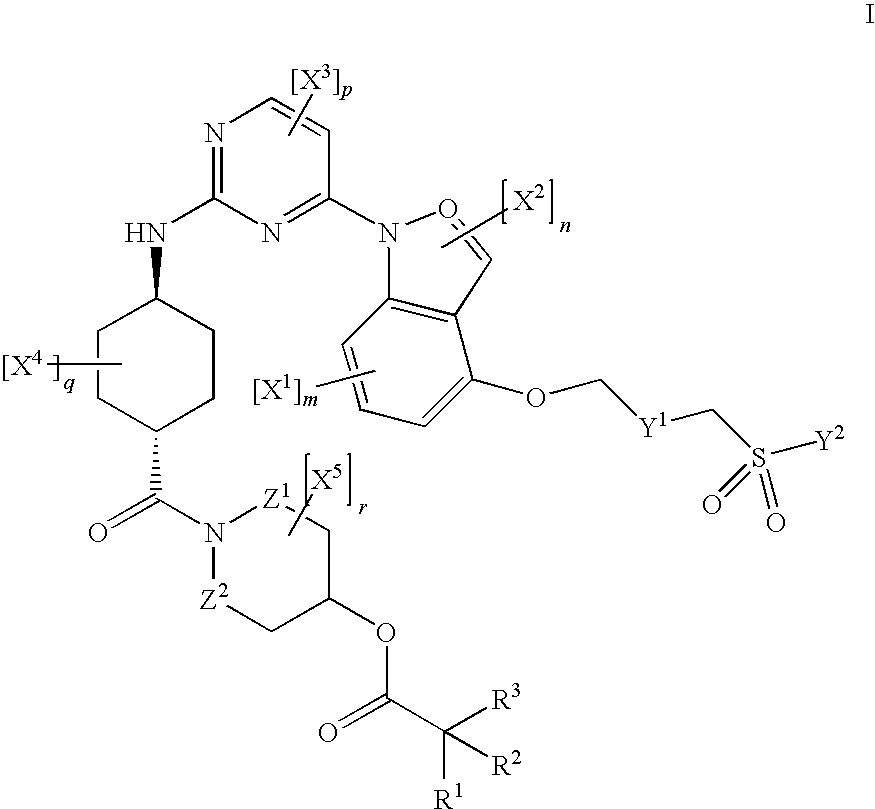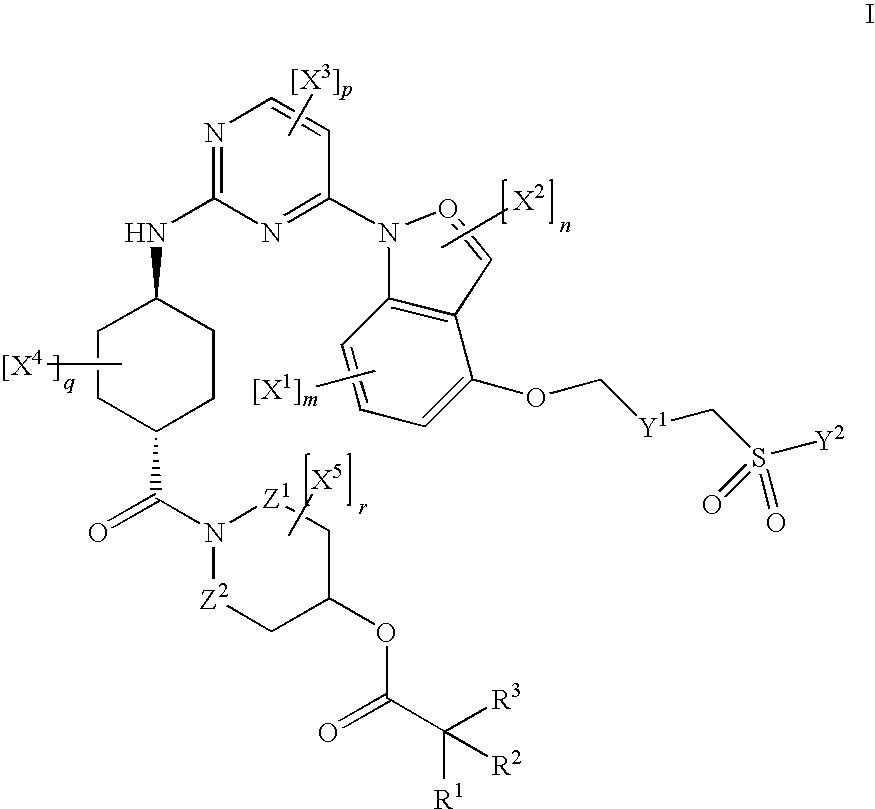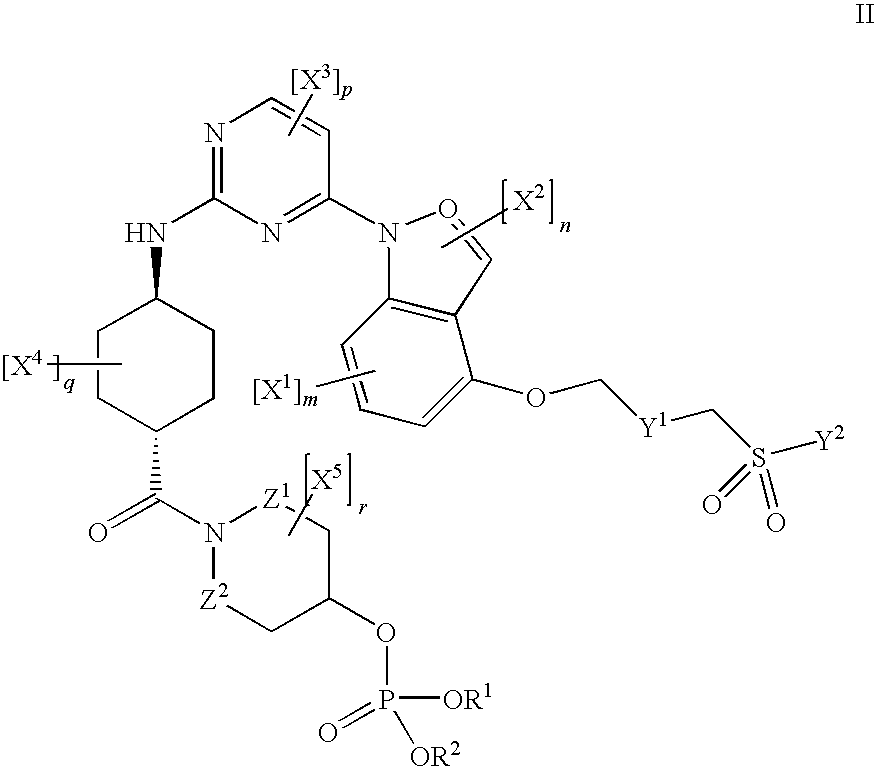Inhibitors of JNK
a technology of jnk and inhibitors, which is applied in the field of inflammatory disorders and medical chemistry, can solve the problems of malignant tumor formation, debilitating joint damage and deformation of most ra patients, and end up with debilitating joint damage and deformation
- Summary
- Abstract
- Description
- Claims
- Application Information
AI Technical Summary
Benefits of technology
Problems solved by technology
Method used
Image
Examples
example 1
[0405]
[0406]To a suspension of 1.0 mMol (0.556 g) I in 20 mL DCM, 5.0 mMol (1.032 g) DCC and 3.0 mMol (0.367 g) DMAP were added, and stirred at r.t. for 5 minutes under N2. 2.0 mMol (0.406 g) II was then added and stirred at r.t. for 1 h. The reaction mixture was then diluted with DCM, washed with H2O (×4) and brine. The organic layer was then dried with Na2SO4, filtered, and solvent removed in vacuo. The residue was purified on a silica gel column (1.5-5%, MeOH-DCM), and the solvent removed to yield 0.656 g III as the free base ([M+1] 741).
example 2
[0407]
[0408]To a suspension of 1.0 mMol (0.556 g) I in 20 mL DCM, 5.0 mMol (1.032 g) DCC and 3.0 mMol (0.367 g) DMAP were added, and stirred at r.t. for 5 minutes under N2. 2.0 mMol (0.206 g) II was then added and stirred at r.t. overnight. The reaction mixture was then diluted with DCM, washed with H2O (×4) and brine. The organic layer was then dried with Na2SO4, filtered, and solvent removed in vacuo. The residue was purified on a silica gel column (2.0-6.5%, MeOH-DCM+0.1% NH4OH), and the solvent removed to yield 0.398 g III as the free base. 157 mg III was then dissolved in EtOAc with a few drops of EtOH, on a steam bath and allowed to cool to r.t., and 10% ethanolic HCl was added. After concentrating, the solution was stirred into Et2O to yield III, a light yellow precipitate as the HCl salt.
example 3
[0409]
[0410]To a solution of 0.656 g I in 1 mL DCM on an ice bath was added 1 mL TFA and allowed to stir for 1 hour on ice and subsequently several hours at r.t. The mixture was purified on a silica gel column (2.5-10% MeOH-DCM+0.1% NH4OH), stirred in EtOAc-hexane, the resultant solid filtered off and dried in vacuo at 50° C. to yield 0.265 g II (MP: 182-183° C., M+1: 641). 148 mg II was dissolved in heated EtOH and 10% ethanolic HCl was then added. Upon addition of Et2O, a light yellow precipitate formed, was allowed to stir overnight, and the solid filtered under N2 and dried in vacuo at 50° C. (158 mg HCl salt of II).
PUM
| Property | Measurement | Unit |
|---|---|---|
| current amplitude | aaaaa | aaaaa |
| particle size | aaaaa | aaaaa |
| volume | aaaaa | aaaaa |
Abstract
Description
Claims
Application Information
 Login to View More
Login to View More - R&D
- Intellectual Property
- Life Sciences
- Materials
- Tech Scout
- Unparalleled Data Quality
- Higher Quality Content
- 60% Fewer Hallucinations
Browse by: Latest US Patents, China's latest patents, Technical Efficacy Thesaurus, Application Domain, Technology Topic, Popular Technical Reports.
© 2025 PatSnap. All rights reserved.Legal|Privacy policy|Modern Slavery Act Transparency Statement|Sitemap|About US| Contact US: help@patsnap.com



